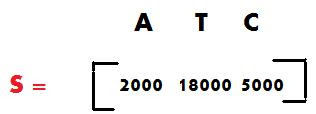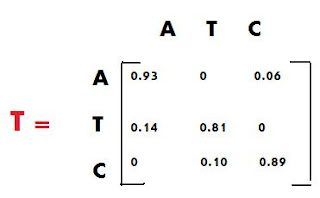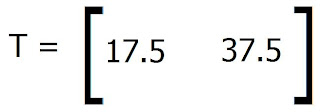Let's start with a definition. "Matrix - (mathematics) a rectangular array of quantities or expressions set out by rows and columns, treat as a single element and manipulated according to rules." (courtesy of "thefreedictionary.com").
To elaborate, a matrix is always either rectangular or square, has a title (usually a single letter), and its name is derived by the title followed by the number of rows, followed by the numbers of columns.
For example:
A [1 3 -5 9] is named A, 1x4. The title of the matrix is "A", while it has one row, and four columns.
Similarly, each number (element) in the matrix is assigned an "address". The address is the lowercase letter of the matrix title, followed by the position in the rows, followed by position in the columns.
For example:
F [4 7 3 -11] is composed of:
f1,1... (4)
f1,2... (7)
f1,3... (3) and
f1,4... (-11)
Here is another matrix, with numbered columns and rows.
A 1 2 3
1[ -11 66 43]
2[ 4 74 22]
3[ 5 9 18]
4[ -8 12 -1 ]
5[ 15 -9 15]
This matrix is a 5x3 matrix, and as an example, the element found at "a 4,2" is 12.
In addition to these conventions, there are rules for matrix addition and subtraction.
Rule 1: The matrices must have the same dimensions. (such as being 1x4 + 1x4, or 8x2 + 8x2, or what have you.)
Rule 2: Matrices are added by simple addition (as well as subtracted through simple subtraction) of the respective elements on each matrix. Allow me to explain.
A [4 5 -1 -19] + T[-14 7 -3 8] is added thusly...
a1,1 + t1,1
a1,2 + t1,2
a1,3 + t1,3
a1,4 + t1,4
And the resultant matrix would appear [-10 12 -4 -11], and its title would be an arbitrarily assigned number or symbol, in context, hopefully one with some meaning.
Furthermore, there is an additional type of matrix I would like to explain. The Identity Matrix. The identity matrix is composed entirely of zeros and ones, because any number add or subtract zero is itself, while any number multiplied or divided by one is itself. Also, the identity matrix has only ones along a diagonal, with only zeros on either side. It may look something like this.
[1 0 0 0]
[0 1 0 0]
[0 0 1 0]
[0 0 0 1]
In closing, everyone please check the Digital Ethics post so that tomorrow in class we can take our oaths quickly and efficiently. Also, Glenn (roe on the contributor list) will be tomorrow's scribe.
















 and B =
and B =  Which of the following matrices is equal to the matrix
Which of the following matrices is equal to the matrix 


















